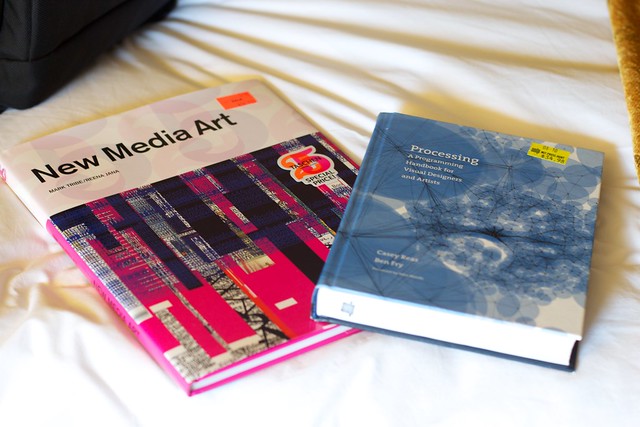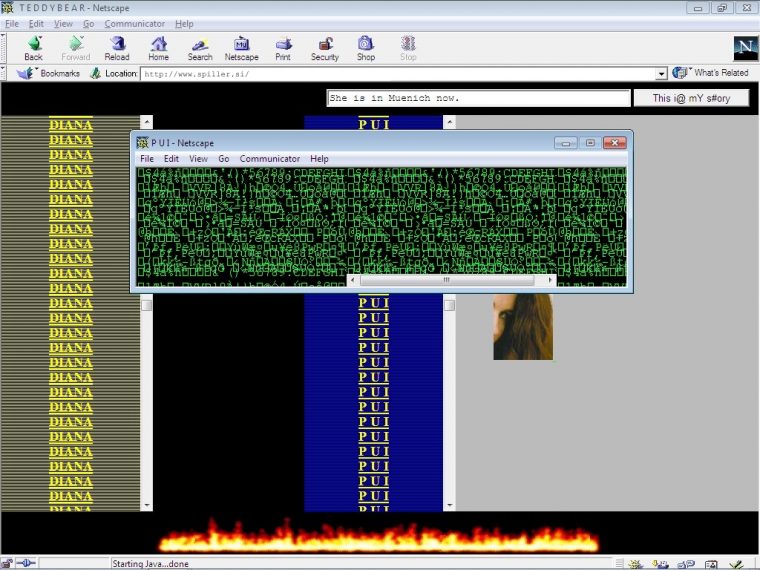What does the quirky web art of the 1990s, an era before networked video was viable, palettes of 256 colors… have to do with the web of 2019?
Maybe everything.
Through my old tech ways of scouring the web (RSS Reader) today came another gem from Jay Hoffman’s History of the Web project. It’s not just the nostalgia I like, it’s his deeper than typical research and solid writing that draws me in.
Today it was A Love Letter to Net.Art

I pretty much am going to yank some quotes, and intersperse with images from one of the corners of the web where this counter-commercial ideal still lives – works tagged art in codepen.
There is not one thing that defines a net artist, and I think you’ll find that their work is as varied as the personalities of its creators. Their connection, therefore, is grounded in a shared understanding of the possibilities of the Internet. These were a group of individuals who saw the web not as a means of utility, say purchasing something or reading an article, but as a means of collaborative expression created by the artist and experienced by the visitor. They were the web’s rogue avant garde movement, set apart from both from the wider web world, where the focus increasingly moved towards business interests and commercialization, and the mainstream art world which overlooked them for years. And in that middle-ground reality, they created brilliant works of art.
A Love Letter to Net.art https://thehistoryoftheweb.com/net-art/

The web’s a particularly versatile medium because of how fundamentally collaborative it is. We forget that sometimes, but the web’s superpower is connection. The nettime mailing list, and the discussion and community that formed around it, was as important as any one creator’s website or experiment. The web’s homogeneity was created by people, and there’s nothing about the medium that says everything needs to look the same. One of the stated goals of
A Love Letter to Net.art https://thehistoryoftheweb.com/net-art/net.artwas to push back on the commercialization of the web, and they did so by discussing alternatives to the mainstream web. So, a lot of their experiments were simple, and not every single one of them landed, but in their crudeness was the beauty of exploration, a uniqueness that you couldn’t find anywhere else. They created works of art that were vast and immersive, and intimate and personal.

The
A Love Letter to Net.art https://thehistoryoftheweb.com/net-art/net.artmovement, and all of its magnificent creations, is a wonderful story because it’s about a whole lot of free thinking individuals feeling around in the dark and not taking for granted what the web was and what it could be. And as I read more about it, I realized that if we play our cards right, we’re poised for another moment just like it. The web is once again being deconstructed by its users in new and different ways. You can see it in tools like CodePen and Glitch, which lower the barrier to entry for folks that want to experiment with web technologies. People are building simple and complex things on these platforms, and whole communities have sprung up to encourage collaboration and sharing. There’s no monetization strategies or KPI’s built into these experiments. Their creators just want to see something new on the web.

You can also see the
A Love Letter to Net.art https://thehistoryoftheweb.com/net-art/net.artinfluence in the own-your-own-data mantra of movements like IndieWeb, and the blog what you know spirit of Weeknotes. Or what about those that are encouraging us to keep the web weird or to just write. Or the fact that web standards are finally catching up to the point where we don’t need Facebook and Twitter to talk and share things with friends anymore. I guess what I’m saying is, the lessons ofnet.artare alive and well whenever someone picks up their own domain and does whatever the hell they want with it. It’s all around us, you just have a look. So go get inspired, and go make something.
This spirit of the past web is not dead, it’s in all kinds of quiet corners of the web where people are making stuff for the sake of making it. I find regularly stuff that rather blow my mind for being capable in a web browser window, Just scouting the codepen items tonight led me to p5.js, a means to run the processing visual library in JavaScript.
And if you really want to go down the psychedelic rabbit hole, spend some time in glitch.
I’m straining the memory neurons, as I was not only on the web, but weaving my own bits of it during the net.art era. I vaguely recall things that would be under the umbrella. But it’s vague, and without any kind of narrating, again I’m left with memory.
Reading Hoffman’s Net.Art piece did bring me back to my own related, half done project to revisit works covered in Mark Tribe and Rena’s 2006 book on New Media Art. I had picked up a copy in 2010 (rather ironic to see the other book was one I thought I would learn the Processing language)

Books Scooped at MIT Press Store flickr photo by cogdogblog shared under a Creative Commons (BY) license
I began posting my attempts to find the net.art today in a tumblr site https://re-new-media-art.tumblr.com and even had an assignment for the 2018 #NetNarr class to write a few entries. Quite a few are still on the list to be done.
Is there hope in the web dystopia? Again, back to Hoffman’s words:
it’s about a whole lot of free thinking individuals feeling around in the dark and not taking for granted what the web was and what it could be. And as I read more about it, I realized that if we play our cards right, we’re poised for another moment just like it.
What could the web be? Look to net.art/
Featured Image: Teddy bear (net.art) 2 by Teo Spiller from Wikimedia Commons shared under a Creative Commons CC BY-SA license.



Exciting, The starry night was particularly amazing. I’ve been stumbling around glitch and p5.js a little (too much to do, not enough time). @everythingabili, Tom Smith, is doing some interesting things with p5.js, you might know him?
One of Tom’s sites reminds me a bit of the assessment bank:
https://script.google.com/macros/s/AKfycbzWLCnH5NFlW9fmGqPddiwZcvJfQqWnxMVY_uvRCElMYFYfhkw8/exec?sheet=Inspiration
Without the interactivity, a good resource.
Wow, That sheet by Tom is impressive. Is there a source somewhere (I am guessing it’s sheet driven), especially like the Random part that generates an activity, rather ds106 like
I though you might, I pointed Tom to the Assessment bank and he was impressed. I’ll tweet an intro.